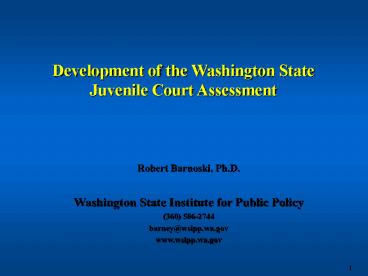Development of the Washington State Juvenile Court Assessment - PowerPoint PPT Presentation
1 / 22
Title:
Development of the Washington State Juvenile Court Assessment
Description:
Social History: school, family, relationships, drug ... Anti-social attitudes. Aggression. Skills. Full Assessment Domains. 17. Sexual Attitudes/Behaviors ... – PowerPoint PPT presentation
Number of Views:56
Avg rating:3.0/5.0
Title: Development of the Washington State Juvenile Court Assessment
1
Development of the Washington State Juvenile
Court Assessment
Robert Barnoski, Ph.D. Washington State
Institute for Public Policy (360)
586-2744 barney_at_wsipp.wa.gov www.wsipp.wa.gov
2
1997 Washington State Legislation Community
Juvenile Accountability Act
- Use a risk assessment to determine which
programs are most likely to be effective with
particular juvenile offenders - Youths eligibility for program is based on risk
assessment - Level of risk for re-offending.
- Profile of risk factors.
3
Todays Talk
- Background
- Assessment Structure
- Assessment Infrastructure
- Uses of Assessment
- Assessment Implementation
4
Purposes of the Assessment
- Estimate level of risk for re-offending.
- Target more intensive efforts at higher-risk
youth, and little effort at low-risk youth. - Guide the probation effort case management
- To create a common language that increases
awareness of factors related to recidivism. - Engage and motivate youth through interview
- Leverage protective factors to reduce risk
factors - Target intervention by assessment profile
- Monitor assessment changes.
- Changing probation practices in 34 juvenile
courts - To know what interventions are effective.
- Have information to guide court efforts.
5
1999 Assessment Development
- Literature Review
- First Draft Reviewed by Court Staff
- First Draft Reviewed by International Experts
- Pilot First Draft
- Revise First Draft Based on Pilot
- Develop and Validate a Subset of Items for
Pre-Screening - Computer Automation
- Implement Assessment
- Validate Full Assessment
- Revise Assessment every three years
6
Keeping the End in Mind
- To institutionalize the assessment and risk
reduction process. - Can best be achieved when the assessment and risk
reduction process help staff to do their job.
7
Purpose of Assessment Has Evolved
- Becoming a way to systematically collect and
organize the youths social file, supervision
progress, and rehabilitative efforts. - As time goes on and needs change, can add domains
and items within domains. - Gather each piece of information once, but use
the information multiple times.
8
Uses of a Systematic Collection of Information
- Pre Adjudication Hold (Risk for violence,
suicide) - Pre-Sentence report
- Custody placement (Risk and problem profile)
- Supervision level (1001, 501, 251).
- Assignment of community intervention.
- Monitoring progress.
- Case management focused on relevant issues.
- Reporting - reduce paperwork.
- Monitoring effectiveness of service delivery.
9
Case ManagementSequence to Self Reliance
- If family has problems
- Engage motivate family
- gt Specific Problems
- gt Generalization
- If not family problems
- Engage motivate youth
- gt Attitudes Skills
- gt Specific Problems
- gt Generalization
10
Mapping Problem to Intervention for Moderate to
High-risk Youth
11
A Multi-Stage Process is Used
- (Pre-adjudication detention hold)
- Information feeds into the . . .
- Pre-Screen
- Information feeds into the . . .
- Initial Assessment.
- Information feeds into the
- Re-Assessments
- Information feeds into the
- Final Assessment
12
Types of Domains
- History Any time in the past.
- Current Within last six months (initial) or the
last four weeks (re-assessment).
13
Types of Items
- Risk Negative factors that increase likelihood
of re-offending. - Protective Positive factors targeted for
change, absence is not a risk. - Static Historic factors, not targeted for
change. - Dynamic Factors targeted for change.
- Check most appropriate/Check all that apply.
- Pivot items Indicate need to complete next part
of domain. - Barriers Factors making it difficult to work
with the youth or family responsivity.
14
Scoring
- Level of risk for re-offending (Low, moderate and
high). - This could be expanded to include risk for
property and/or violent re-offending - Program eligibility score and criteria.
- Domain risk and protective factor scores and
percentiles. - Risk and protective factors are scored to
emphasize change same item can have one
response that is a risk factor, and another
response that is a protective factor.
15
Pre-Screen Domains
- Demographics Age, Gender, etc.
- Court history (criminal)
- Social History school, family, relationships,
drug/alcohol, and mental health
16
Full Assessment Domains
- School
- Free-Time
- Employment
- Family
- Relationships
- Drug/Alcohol
- Mental Health
- Anti-social attitudes
- Aggression
- Skills
17
Additional Future Domains
- Sexual Attitudes/Behaviors
- Physical Health/Vulnerabilities
- Institutional Performance
- Performance on Supervision
- Program/Treatment Performance
- Community Factors
18
Additional Future Items Within a Domain
- For example, add DSM Axis I Diagnosis to mental
health domain - Add whether aggression is instrumental or
impulsive to aggression domain. - Add degree of physical harm inflicted and use of
weapons.
19
Infrastructure to support quality and utility
20
Staff Training and Support
- Oversight Committee
- Statewide Coordinator/Expert
- Regional Trainers
- Regional Consultants
- Court Experts
- Implementation training
- Manuals, Videos, and Sessions
- On-going education and training in techniques
and findings.
21
Staff Skills
Motivation to understand youth and help
youth/family solve their own problems. Structured
interview skills. Understand motivation and
change theory. On-going education in techniques
and findings.
22
Assessment Proliferation
- Must be something to it, since it is being used
in at least a dozen states and multiple courts,
and possibly in Amsterdam. - Service providers particularly like it.































